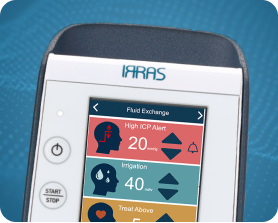Patient Stories
Real Stories. Real Results.
How IRRAflow is changing lives after hemorrhagic stroke.
Patient Info
Understanding Hemorrhagic Stroke.
Key insights into hemorrhagic stroke and its causes.
A Hemorrhagic stroke is caused by a blood vessel in the brain rupturing which leads to bleeding in and around the brain. This type occurs in about 13 percent of all strokes.¹
Hemorrhagic stroke accounts for 10–15% of all strokes and carries very high morbidity and mortality rates that have not changed over the last 30 years. At one year, mortality ranges up to 65% and at six months, only 20% of patients are expected to be independent.2-3
Intracerebral hemorrhages (ICH) is bleeding into the brain tissue, often caused by chronically high blood pressure or aging blood vessels which can be caused by an arteriovenous malformation (AVM), a cluster of abnormally formed blood vessels.
Subarachnoid hemorrhages is bleeding into the cranial space between the brain tissues and the skull. This type is most often caused by high blood pressure, cigarette smoking and excessive alcohol use.
Stroke Info
Stroke Identification and Treatment are key.
Time is brain, act F.A.S.T. if any warning signs are observed.
F
Face Drooping
A
Arm Weakness
S
Speech Difficulty
T
Time to Call 911
Dizziness, loss of balance, a sudden, severe headache or difficulty swallowing are some other common warning signs of a stroke.
Work with your healthcare provider to identify a plan to best manage your risk. This may include controlling high blood pressure, making healthy lifestyle choices and taking medications.
Advanced Technology
Why Choose IRRAflow?
Better outcomes for those with urgent, life-threatening conditions.
Patient Resources
Ready to Take the Next Step?
Download our comprehensive patient guide and discuss with your healthcare provider.
Educational Info
Additional Resources
Links to more resources
National Stroke Association: www.stroke.org
National Institute of Health Stroke Webpage: stroke.nih.gov
World Stroke Association: www.world-stroke.org
American Stroke Association (ASA)-A Division of the American Heart Association: strokeassociation.org
National Institute of Neurological Disorders and Stroke: www.ninds.nih.gov/health-information/public-education/brain-basics
1. Tsao CW, Aday AW, Almarzooq ZI, et al. Heart disease and stroke statistics—2023 update: a report from the American Heart Association. Circulation. 2023;147:e93–e621.
2. Flaherty ML, Woo D, Haverbusch M, et al. Racial Variations in Location and Risk of Intracerebral Hemorrhage. Stroke. 2005;36(5):934–937.
3. Counsell C, Boonyakamkul S, Dennis M, et al. Primary Intracerebral Hemorrhage in the Oxfordshire Community Stroke Project, 2: Prognosis. Cerebrovascular Disease. 1995;5:26–34
4. Carrera DA, Mabray MC, Torbey MT, Andrada JE, Nelson DE, Sarangarm P, Spader H, Cole CD, Carlson AP. Continuous irrigation with thrombolytics for intraventricular hemorrhage: case-control study. Neurosurg Rev. 2024 Jan 10;47(1):40. doi: 10.1007/s10143-023-02270-3. PMID: 38200247; PMCID: PMC11105161.







